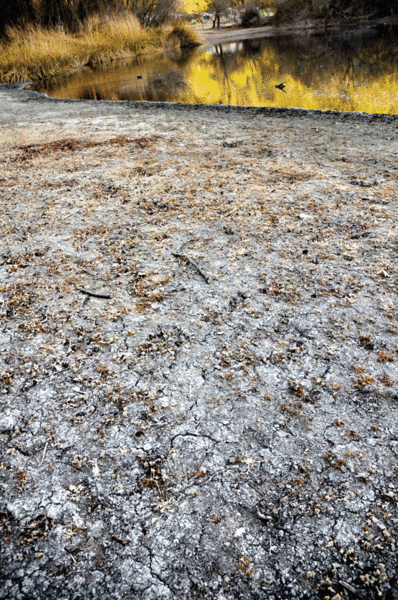With temperatures in the 70s the past several weeks, warm, dry conditions have defined the winter months in Santa Cruz County
While that may make for excellent beach weather local fire and water officials are alarmed by what they describe as historically low levels of rainfall.
“We’re going into our third consecutive year of less-than-normal rainfall,” said San Lorenzo Valley Water District Manager Jim Mueller.
So far in the 2013-2014 rainfall year — which runs from Oct. 1, 2013, to Sept. 30, 2014 — the San Lorenzo Valley has received just 2.5 inches of rainfall. Nearly a third of the way through the water year, the valley has received less than 6 percent of its average annual rainfall of 49.87 inches.
“This current year is historically less,” Mueller said.
According to historical rainfall data, the San Lorenzo Valley normally would have received an average of nearly 28 inches on rain by the end of January.
Piret Harmon, general manager of the Scotts Valley Water District said that the city has received less than an inch of rain — .79 inches — in the current rainfall year, less than 2 percent of the city’s average annual rainfall level of 42.5 inches.
By January, she said, the city has typically received an average of 23.65 inches of rainfall.
“(Rainfall levels are) near to none,” Harmon said.
The typical rainy season in the county typically lasts through May, so while Mueller and Harmon were both hopeful for rainy weather to boost the total precipitation numbers closer to the annual average before summer, both said their respective districts were planning for the worst.
“If it hasn’t rained by early March or April, it’s not likely going to,” Harmon said.
Although neither the Scotts Valley nor the San Lorenzo Valley water districts are yet ready to declare a conservation emergency, both are asking their customers to use their water wisely, and reduce unnecessary usage — such as hosing down a sidewalk.
“We still have two or three relatively reasonable rainfall months left,” Mueller said. “We would just ask our customers to use water wisely and minimize nonessential uses.”
Should dry conditions persist into the summer months, more drastic reduction measures could become a reality, with possible mandatory conservation days, fines for wasted water, designated watering days, and — in the worst case scenario — rationing.
Harmon said that water customers’ single largest source of water usage in Scotts Valley is for outdoor irrigation and landscape uses — as much as 50 percent. Altering or reducing those habits, she said, would go a long way to meeting usage reduction goals.
“People can do a lot without completely giving up their lifestyle choices,” Harmon said.
Harmon said that because much of Scotts Valley’s water is drawn from groundwater as opposed to rainwater in creeks or rivers, the city would likely not feel the effects of drought conditions as quickly.
Fire danger high
The unseasonably dry conditions have ominous implications for fire personnel as well. On Dec. 30, Cal Fire declared a ban on all open burning in Santa Cruz, San Mateo, and Santa Clara counties, citing the dry conditions and the ease that debris fires can spread in such conditions.
Angela Bernheisel, division chief of the Santa Cruz and San Mateo unit of Cal Fire, said that current conditions are similar to how they would typically be in May or June.
Statewide for 2014, Bernheisel said, Cal Fire had responded to 154 wildfires, which burned a total of 598 acres — as of Jan. 11.
In response to the dry conditions, she said, seasonal wildfire crews were being activated to staff wildland fire engines.
“We actually hired back 10 firefighters today,” she said on Wednesday, Jan. 22. “We’re staffing six wildland fire engines in the unit.”
That many firefighters and wildland fire engines being activated and staffed in January is nearly unheard of, she said.
The firefighters are typically seasonal fire crews brought on during the summer months — “normally not till May or June” — to battle wildfires, Bernheisel said.
“Everybody’s been really worried,” she said. “Nobody working in fire service has seen a situation like this on January 22 in this area.”
– To comment, email reporter Joe Shreve at jo*@*********er.com, call 438-2500 or post a comment at www.pressbanner.com.












